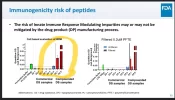Greetings ,
I just finished 2 months of pharma Tirz, fist month not much action at 2.5mg, second month things started popping a little a 5mg, some minor side effects , but we perservered. The price increases with dosage increases with my provider, so I wanted to try a more cost effective approach, I purchased some from my peptide supplier with a Jano report and went up to my next level of 7.5mg, been a week , I would say the food noise is gone, the weight has stopped coming off , I was starting to average 1.5 pounds a week, now I'm heading in the other direction, 2 pounds in a couple of days water weight. I have a tendency to under hydrate.
I always overthink this shit and try to hard, any thoughts ? suck it up and go back to the pharma ?
Looking forward to sme great thoughts as usual, thanks in advance for your help.
I just finished 2 months of pharma Tirz, fist month not much action at 2.5mg, second month things started popping a little a 5mg, some minor side effects , but we perservered. The price increases with dosage increases with my provider, so I wanted to try a more cost effective approach, I purchased some from my peptide supplier with a Jano report and went up to my next level of 7.5mg, been a week , I would say the food noise is gone, the weight has stopped coming off , I was starting to average 1.5 pounds a week, now I'm heading in the other direction, 2 pounds in a couple of days water weight. I have a tendency to under hydrate.
I always overthink this shit and try to hard, any thoughts ? suck it up and go back to the pharma ?
Looking forward to sme great thoughts as usual, thanks in advance for your help.


